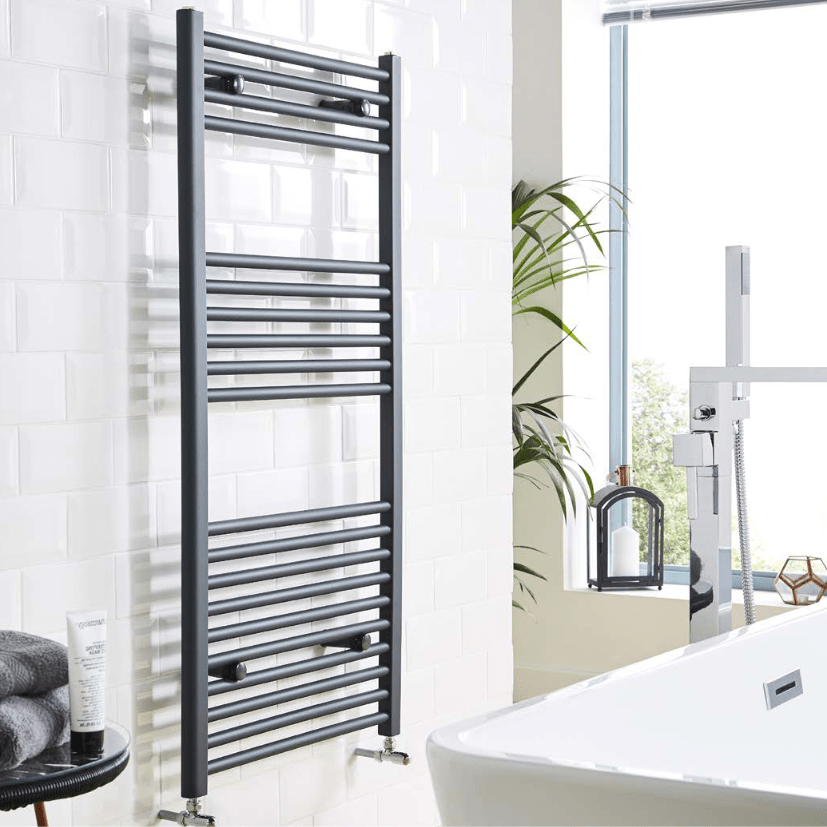01 864 5119

The Ultimate Guide to Buying Heated Towel Rails 2025
A heated towel rail is one of those small upgrades that can make a big difference to everyday life. There’s nothing quite like stepping out of the shower to a warm, dry towel especially on a cold morning.
But with so many styles, sizes, and types available, choosing the right heated towel rail can feel overwhelming. This guide covers everything you need to know before buying one, from how they work to what style and material might suit your space best.
What Does a Heated Towel Rail Do?
At its core, a heated towel rail keeps your towels warm and dry. But in smaller bathrooms, ensuites or cloakrooms, it can often double up as the room’s main heat source too.
Modern towel rails come in a huge range of designs, so whether you want a minimalist, ultra-modern look or a more traditional feature, there’s an option out there for every style.
Types of Heated Towel Rails
Choosing the right type depends largely on your heating system and how you plan to use the rail.
Central Heating Towel Rails
Connected to your existing heating system, these rails heat up whenever your heating is on. They’re a straightforward and cost-effective choice for most homes.
Electric Towel Rails
Perfect for rooms without existing heating pipes or where flexibility is needed. They run independently from your main heating system and are usually controlled by a timer or thermostat.
Dual Fuel Towel Rails
A combination of both. These connect to your central heating but also have an electric element, allowing them to be used even when the heating is off — ideal for drying towels in summer.
Sizing & Heat Output
Getting the right size is crucial. A towel rail that’s too small won’t warm your towels properly, while one that’s too big might overwhelm the space or waste energy.
Measure your available wall space carefully and think about how many towels you’ll typically hang. If heating the room is important too, check the rail’s BTU (British Thermal Unit) output to ensure it meets your needs.
Slim vertical rails are perfect for tight or narrow spaces, while ladder-style rails with lots of bars are great for family bathrooms with multiple towels.
Materials: What’s Best?
The material of your towel rail affects both its performance and appearance.
Mild Steel: The most common and affordable option. Holds heat well and comes in many finishes.
Aluminium: Lightweight, heats up quickly, and uses less energy — great for efficiency.
Stainless Steel: Rust-resistant and durable. An excellent choice for damp or coastal environments.
Design & Finish Options
Heated towel rails have come a long way in design, giving you the chance to complement or contrast your bathroom style.
Popular finishes include:
Chrome or Polished: Timeless and versatile, pairs well with taps and fittings.
White: Clean and understated, perfect for traditional spaces.
Black or Anthracite: A modern, striking choice that adds contrast.
Designer Colours: Increasingly popular for adding personality or matching your bathroom palette.
Flat or curved ladder rails provide plenty of hanging space, while more contemporary models might feature shelves or creative designs.
Where Should You Install Your Towel Rail?
Ideally, your towel rail should be within easy reach of your shower or bath, so towels are accessible when you step out.
It’s often recommended to place them on the coldest wall (usually an external one) to help distribute heat effectively around the room. But it’s equally important to avoid obstructing doors or windows and to allow enough space for the rail’s projection from the wall.
If replacing an existing rail, check the measurements between pipe inlets (pipe centres) to help with a straightforward swap.
Heating the Room vs Drying Towels
If your bathroom is small, a heated towel rail may provide enough warmth on its own. But for larger rooms, combining a towel rail with a standard radiator often gives the best result — one warms the room, the other keeps towels toasty.
For dual-purpose use (heating towels and the room), look for towel rails with higher BTU ratings or larger designs.
Installation Tips
Swapping out an old towel rail for a like-for-like replacement can sometimes be tackled as a DIY project if you’re confident. But if you’re moving pipework, adding a dual fuel element, or installing an electric-only model, it’s highly recommended to hire a qualified plumber or electrician.
Professional installation also ensures compliance with safety standards, particularly for electric models near water.
Final Thoughts
A heated towel rail is a simple way to add both style and comfort to your bathroom. It keeps towels warm and dry, helps reduce damp, and can contribute to heating the space all while becoming a stylish feature in its own right.
When choosing yours, keep these key points in mind:
Consider how you’ll use it: heating the room, drying towels, or both.
Measure carefully and check pipe centres.
Pick a material and finish that suits your space.
Decide between central heating, electric, or dual fuel.
Think about how many towels you’ll want to hang.
Get professional advice if needed for installation.
With so many styles, sizes, and materials available, it’s easier than ever to find a towel rail that works perfectly for your home and makes those cold winter mornings feel that little bit better.
We have a massive range of towel rails here at Bathroom Warehouse. Find all you need by visiting our website. Click here to find out more.
